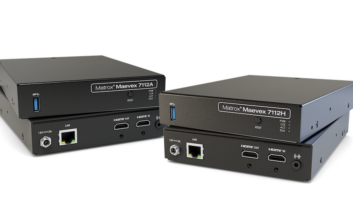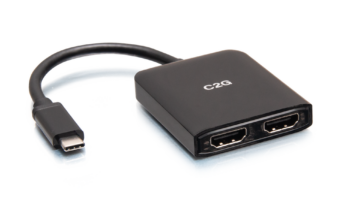By Joseph Palenchar
— Home-theater systems have more strings attached than a government bailout, so vendors are coming to International CES with different strategies to eliminate the strings.
Wireless technologies are appearing here in consumer products and chipsets to eliminate speaker cables in surround-sound systems and to replace HDMI A/V cables between high-definition video sources and displays.
Also at CES, fabless semiconductor maker Valens plans to demo a technology that eliminates some strings by letting high-definition video share a wired Ethernet network with PC data.
Here’s what dealers and engineers will find at the show:
Acoustic Research: The Audiovox brand plans to show a $699-suggested wireless conversion kit that turns an existing 5.1-channel surround system into a wireless surround system. The ARW51 kit, already available, consists of a transmitter and six wireless receiver/50-watt amplifiers that connect individually to speakers. The transmitter delivers six full-bandwidth 16-bit CD-quality channels. The system features diversity antennas to overcome multipath interference, code-hopping technology to avoid interference with 2.4GHz networks and cordless phones, and intelligent error correction.
Focus Enhancements: The Campbell, Calif.-based fabless semiconductor developer plans to demo a multichannel wireless-audio technology said to overcome the sound quality, interference, latency and cost challenges associated with other wireless technologies designed for multichannel home theaters.
The company’s Summit technology promises 7.1-channel sound quality that’s “virtually indistinguishable” from wired quality, and it’s affordable enough for use in midprice home theater in a box (HTiB) systems, said chief technical officer Michael Hudson. Summit achieves its quality goals by, among other things, transmitting uncompressed 48kHz/24-bit PCM over the air, using forward error correction to overcome latency problems, and using the uncongested 5.1-5.8GHz U-NII band, which was recently approved by the International Telecommunications Union (ITU) for worldwide unlicensed use near the IEEE 802.11a/n wireless-network band.
The cost of embedding these technologies with “good-quality” amplification into all of the speakers of a $599-suggested HTiB would match the cost of building a wired HTiB with the same performance, Hudson claimed. At prices starting at $799, a Summit-equipped HTiB would actually be less costly to build than a wired HTiB with similar performance, he said.
Hudson cited multiple reasons for the cost advantage. One is the elimination of passive crossover parts because Summit’s in-speaker chip incorporates digital active crossover. Another reason would be that power supplies embedded in each speaker would be smaller than the power supplies located centrally in an HTiB system’s main chassis.
The Summit chip also features speaker-level, speaker delay, and phase controls flexible enough to focus the sweet spot into one corner of a room where a sectional couch might be placed, Hudson noted.
Radiient Technologies: The company has teamed up with THX to jointly market and license THX Roomcaster ultrawideband (UWB) wireless technology, developed by Radiient to distribute up to 7.1 channels of audio up to 30 feet in a home.
The technology can be embedded in A/V receivers, iPod docks, game consoles, speaker systems and headphones to send and receive up to eight channels of uncompressed 96kHz, 24-bit audio, the companies said. THX Roomcaster can also be integrated into add-on accessories that consumers can attach directly to existing wired audio systems to make them wireless.
The technology appears in Radiient’s Roomcaster Early Adapter kit, a $1,999 system composed of one transmitter and six speaker adapters for attachment to any existing 5.1-channel sound system. The company will be at CES taking orders for the system, which is a modified version of the Roomcaster Development Platform that Radiient is making available to OEMs to support the integration of Roomcaster into their products, the company said. The kit is targeted to audio enthusiasts and early adopters who don’t want to wait for Roomcaster-embedded products to appear, likely later in 2009, Radiient said.
Radiient’s solution rides on top of the UWB standard adopted by the WiMedia Alliance and uses a proprietary streaming audio protocol to prevent the signal dropout and lip-sync problems that plague other wireless solutions, the company said. Roomcaster also synchronizes the sound coming out of multiple speakers in a multichannel sound system. Because it creates a wireless mesh network, when THX Roomcaster detects one speaker receiving a weak signal, another speaker automatically retransmits the signal to it, the companies said.
SiBeam: The company will demo the industry’s first WirelessHD chipset solution using affordable CMOS ICs.
Wireless HD technology is an in-room wireless technology that replaces wired HDMI connections among audio and video components. The technology is promoted as delivering no-loss uncompressed copy-protected high-definition video between different-brand components within a room up to 10 meters. It supports resolutions up to 1080p. The technology isn’t designed to penetrate walls to deliver multiroom video.
The technology cuts the HDMI cord between flat-screen TVs and cable- and satellite-TV set-top boxes, DVRs and other video sources.
The technology uses Digital Transmission Content Protection (DTCP) encryption technology approved by the Digital Transmission License Administrator organization to stream HD video to a DVR for copying, not just to a display, and to a portable device from a settop box or game console, SiBeam said.
Valens: The Israel-based fabless semiconductor company will demonstrate wired-network technology that delivers uncompressed HD video up to 8Gbps, audio, control signals and power up to 328 feet over an Ethernet network’s CAT-5e/-6 cable. The technology, HDBaseT, is compatible with various content-protection technologies, the company said.
The technology can be embedded in HD source units such as Blu-ray players and set-top boxes and in displays. Receiver and transmitter ICs will be available commercially in the second half.










